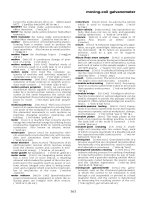Coatings Technology Handbook Episode 2 Part 6 pps
Bạn đang xem bản rút gọn của tài liệu. Xem và tải ngay bản đầy đủ của tài liệu tại đây (386.35 KB, 15 trang )
60
-6
Coatings Technology Handbook, Third Edition
Within a given chemical group, increasing molecular weight results in a modest increase in tensile
strength and modulus, increased solution viscosity, and a modest increase in solvent and chemical
resistance. In general, even the lowest molecular weight grades of these reins are high enough in molecular
weight to be well within the chain entanglement region of the E
′
spectrum such that physical properties
do not change drastically as molecular weight increases. Molecular weight variations can be used effectively
to control the rheology/viscosity of coatings formulations more than the properties of the final coating.
60.3.3 Solution Viscosity
Solution viscosity is a function of chemical composition, molecular weight, and solvent composition.
Within a given chemical class, solution viscosity in a given solvent will increase with molecular weight.
The effect of solvent composition on solution viscosity is more complex and not within the scope of this
discussion. Solvent systems are often chosen for a variety of reasons other than viscosity: drying rate,
toxicity and other environmental concerns, utility with other resins needed in a formulation, etc. Usually
TA BLE 60.3
Solubility of Butvar Resins
a
Solvent
Butvar Solutions Agitated at Room Temperature for 24 h
5% Solid Solution
10% Solids Solution
B–72, B–73, B–74 B–76, B–79, B–90, B–98
Acetic acid (glacial) S S S
Aceton I S SW
Butyl acetate I S PS
n
-Butyl alcohol S S S
Butyl cellusolve S S S
Cyclohexanone S S S
Diacetone alcohol PS S S
Diisobutyl ketone I SW I
N
,
N
–Dimethylacetamide S S S
N
,
N
–Dimethylformamide S S S
Dimethyl sulfoxide S S S
Ethyl acetate, 99% I S PS
Ethyl acetate, 85% S S S
Ethyl alcohol, 95%, or anhydrous S S S
Ethylene dichloride SW S SW
Ethylene glycol I I I
Isophorone PS S S
Isopropyl alcohol, 95%, or anhydrous S S S
Isopropyl acetate I S I
Methyl acetate I S PS
Methyl alcohol S SW S
Methyl ethyl ketone SW S PS
Methylene chloride PS S S
Methyl isobutyl ketone I S I
Naphtha (light solvent) I SW I
N
–Methyl–2-pyrrolidone S S S
Propylene dichloride SW S SW
Te t r a c hlorethylene SW SW SW
Te t r a h y d r o furan S S S
To l u e n eIPSSW
To luene/ethyl alcohol (95%) (60:40 by weight) S S S
1, 1, 1–Trichloroethane SW S SW
Xylene I PS SW
a
Key: S, Completely soluble; PS, partially soluble; I, insoluble; SW, swells (hazy, turbid).
Source:
Butvar/Formvar Brochure,
publication no. 6.70E, Monsanto Chemical Company, Plastics and Resins
Division, St. Louis, MO.
DK4036_book.fm Page 6 Monday, April 25, 2005 12:18 PM
© 2006 by Taylor & Francis Group, LLC
Polyvinyl Acetal Resins
60
-7
by judicious experimentation, a compromise solvent system can be found that will give a reasonable mix
of the required properties.
60.3.4 Plasticizers
Plasticizers are often used to soften the films prepared from the polyvinyl acetals. Among the suggested
plasticizers for polyvinyl butyral are butyl benzyl phthalate, 2-ethylhexyl diphenyl phosphate, dihexyl
adipate, and a verity of other phosphate, phthalate, adipate, sebacate, and ricinoleate esters. Rosin-based
polyester, and blown linseed oil plasticizers are also used.
Diethyldiphenyl and dicyclohexyl phthalates, butyl benzyl phthalate and phosphate ester including 2-
ethylhexyl diphenyl phosphate polyester, chlorinated naphthalenic, and adipate diesters are useful for
polyvinyl formal. By proper choice of plasticizer type and level, the physical–mechanical, chemical, and
adhesion properties of these resins can be tailored for a wide variety of applications. Fitzhugh and
Crozier
5
have studied the effect of a number of plasticizers on the mechanical properties of polyvinyl
acetal resins.
TA BLE 60.4
Typical Physical and Chemical Properties of Formvar Polyvinyl Formal Resin
Properties
ASTM
Method
a
Formvar Resins
5/95E 6/95E 7/95E 15/95E
Physical
Form White, free-flowing powder
Volatiles, maximum, % 2.2 2.2 2.2 2.2
Molecular weight
×
10
–3
(weight average) (1) 25–35 35–45 40–60 70–150
Solution viscosity 15% by wt, MPa
+
8 (2) 140–280 250–500 325–675 1800–3500
Resin viscosity (2) 8–12 12–15 15–20 37–53
Specific gravity, 23
°
/23
°
(
±
0.002) D792–50 1.227 1.227 1.227 1.227
Burning rate, cm/min D635–56T 2.0 2.3 2.3 2.5
Refractive index (
±
0.0005) D542–50 1.502 1.502 1.502 1.502
Water absorption (24hs), % D570–59aT 1.2 1.2 1.2 1.2
Hydroxyl content, as % polyvinyl alcohol D1396–58 5.0–6.5 5.0–6.5 5.0–6.5 5.0–6.5
Acetate content, as % polyvinyl acetate D1396–58 9.5–13.0 9.5–13.0 9.5–13.0 9.5–13.0
Formal content, as % polyvinyl formal, approx 82 82 82 82
Chemical
b
Resistance to
Weak acids D543–56T E E E E
Strong acids D543–56T E E E E
Weak bases D543–56T E E E E
Wtrong bases D543–56T E E E E
Organic solvents
Alcohols D543–56T G G G G
Chlorinated D543–56T P P P P
Aliphatic D543–56T E E E E
Aromatic D543–56T G G G G
Esters D543–56T G G G G
Ketones D543–56T G G G G
a
The ASTM method noted for hydroxyl content and acetate content refers specifically to polyvinyl butyral resins.
However, the same method is applicable to the polyvinyl formal resins. All other properties were determined by ASTM
methods except: (1) molecular weight was determined by SEC/LALLS in hexafluoroisopropanol; (2) solution viscosity
was determined in 15% by weight solutions in 6:40 toluene/ethanol at 25
°
C, using a Brookfield viscometer. Resin
viscosity — 5 g resin made to 100 ml with ethylene dichloride — measured at 20
°
C using an Ostwald viscometer.
b
Key: E, excellent; G, good; F, fair; P, poor.
Source:
Butvar/Formvar Brochure,
publication no. 6.70E, Monsanto Chemical Company, Plastics and Resins Division,
St. Louis, MO.
DK4036_book.fm Page 7 Monday, April 25, 2005 12:18 PM
© 2006 by Taylor & Francis Group, LLC
60
-8
Coatings Technology Handbook, Third Edition
60.3.5 Toxicology
Butvar resins are regulated by the U.S. Food and Drug Administration under the Code of Federal
Regulations, as indirect food additives. Butvar resins have also been subjected to acute toxicity studies
on laboratory animals. Subject to the appropriate regulations, they are useful in a number of packaging
applications for both fatty and aqueous foods.
Both Butvar and Formvar resins have flash points in excess of 370
°
C. The lower explosive limit (LEL)
for Butvar dust in air is 20 g/m
3
. Although these materials are considered to be nontoxic in ordinary
everyday handling, good industrial hygienic practices should be observed when using them.
TA BLE 60.5
Typical Mechanical, Thermal, and Electrical Properties of Formvar Polyvinyl Formal Resin
Properties
a
ASTM
Method
Formvar Resins
5/95E 6/95E 7/95E 15/95E
Mechanical
Te nsile strength, MPa
Yield D638–58T 59–66 59–66 59–66 59–66
Break D638–58T 52–59 52–59 52–59 52–59
Elongation, %
Yield D638–58T 7777
Break D638–58T 50 50 50 50
Modulus of elasticity (apparent), GPa D638–58T 2.7–3.1 2.7–3.1 2.7–3.1 2.7–3.1
Flexural strength, yield, MPa D790–59T 117–124 117–124 117–124 117–124
Hardness, Rockwell
M D785–51 150 150 150 150
E D785–51 65 65 65 65
Notched Izod impact strength (1.25 cm
×
1.25 cm), J/m
D256–59 70 70 70 70
Thermal (
°°
°°
C)
Flow temperature, 6.9 MPa D569–59 140–150 140–150 140–150 160–170
Glass temperature
b
103–113 103–113 103–113 103–113
Heat distortion temperature D648–56 83–87 85–90 85–90 87–93
Heat-sealing temperature
c
96 96 99 107
Electrical
Dielectric constant
50 Hz D150–59T 3.2 3.2 3.2 3.4
1 kHz D150–59T 3.3 3.3 3.3 3.0
1 MHz D150–59T 3.1 3.1 3.1 2.8
10 MHz D150–59T 3.0 3.0 3.0 2.8
Dissipation factor
×
10
3
50 Hz D150–59T 8.1 8.1 8.1 8.7
1 kHz D150–59T 10 10 10 10
1 MHz D150–59T 21 21 21 21
10 MHz D150–59T 19 19 19 18
Dielectric strength (3.2 mm thickness), V/m
Short time D149–59 24 13 13 12
Step by step D149–59 12 12 12 13
a
Conversion factors: MPa
×
145
=
psi; GPa
×
145
×
10
3
=
psi; J/m
×
53.38 lb-ft/in.
b
Glass temperature (
T
g
) was determined by differential scanning calorimeter.
c
Heat-sealing temperature was determined on a 25 m dried film on paper, cast from a 10% solution in 60:40
toluene/ethanol. A dwell time of 1.5 sec at 414 kPa (60 psi) line pressure was used on the heat sealer.
Source:
Butvar/Formvar Brochure,
publication no. 6.70E, Monsanto Chemical Company, Plastics and Resins
Division, St. Louis, MO.
DK4036_book.fm Page 8 Monday, April 25, 2005 12:18 PM
© 2006 by Taylor & Francis Group, LLC
Polyvinyl Acetal Resins
60
-9
60.4 Surface Coating Applications
60.4.1 Polyvinyl Butyral
2,8
The inherent properties of adhesion to a wide variety of surfaces, film toughness and chemical/solvent
resistance, and film clarity of the polyvinyl butyral resins makes them the vehicle of choice in a wide
variety of specialty coating applications. They adhere tenaciously to most polar surfaces: wood, glass,
metals, ceramics, pigments, etc. Their high binding efficiency allows them to be used at very high pigment
loadings. Ceramic films are typically cast in thicknesses from fractions of a mil to several millimeters,
TA BLE 60.6
Solubility of Formvar Resins
a
Solvent
Formvar Resins
15/95E, 7/95E, 6/95E, 5/95E
Acetic acid (glacial) S
Acetone I
Aniline S
Benzene I
Butyl alcohols I
Butyl acetate I
Carbon disulfide I
Cresylic acid S
Cyclohexanone I
Diacetone alcohol I
Diisobutyl ketone I
Dimethyl sulfoxide S
N, N
–Dimethylacetamide S
N, N
–Dimethylformamide S
Ethyl acetate, 99% I
Ethyl acetate, 85% I
Ethyl alcohol, 95%, or anhydrous I
Furfural S
Hexane I
Isopropyl alcohol, 95%, or anhydrous I
Methyl acetate I
Methyl alcohol I
Methyl benzoate S
Methyl butynol S
Methyl cellosolve acetate I
Methyl ethyl ketone I
Methyl isobutyl ketone I
Methyl pentynol S
N
–Methyl–2–pyrrolidone S
Nitropropane I
Pentoxol I
Propyl alcohols I
Phenol S
Propylene dichloride I
Te trachlorethane S
Te t r a h y d rofuran S
To luene/ethyl alcohol (95%) (60:40 by weight) S
To l u e n e I
VM&P Naphtha I
Xylene I
Xylene-
n
-butyl alcohol (60:40 by weight) I
a
Key: S, Completely soluble; I, insoluble or not completely soluble.
Source:
Butvar/Formvar Brochure,
publication no. 6.70E, Monsanto Chemical
Company, Plastics and Resins Division, St. Louis, MO.
DK4036_book.fm Page 9 Monday, April 25, 2005 12:18 PM
© 2006 by Taylor & Francis Group, LLC
60
-10
Coatings Technology Handbook, Third Edition
using 4 to 5% Butvar B-76 as the sole binder
6
; most permanent coatings applications will require con-
siderably higher binder levels than this for adequate film strength. Polyvinyl butyral resins have been used
as the binder of choice in thermophotographic and photographic coatings,
7
in photoconductive coatings,
in electrophotographic coatings, and as a coating on optical recording disks, all of which depend on film
toughness, binder efficiency, and optical clarity. Their toughness, chemical and heat resistance, and
binding efficiency render them useful in powder coatings and photothermographic coating applications.
Polyvinyl butyrals are used extensively as wood coatings, where their resistance to natural wood oils
makes them a primary choice for sealers and wash coats. An example of an application on the Western
Pine Association Knot Sealer number WP578 is given in Table 60.8. A well-known application of polyvinyl
butyrals is in the manufacture of wash primers for the priming of metal surfaces to be used in hostile
environments (e.g., the hulls of naval vessels). There are a number of formulations available, both single-
and two-package systems. Another example of a metal coating based on polyvinyl butyral is Metal Coating
Other coating applications of the polyvinyl butyrals include solder masks for printed circuit board
manufacture, heat-fusible wire coatings, and zinc oxide-based photosensitive paper coatings; they also
serve as the binder/vehicle for iron oxide in the production of magnetic recording tapes. They are widely
used as toughness/flexibility/adhesion promoters in the production of inks for letterpress, flexographic,
and gravure printing, and as a component in toners for reprography.
60.4.2 Polyvinyl Butyral Dispersions
The dispersion of plasticized polyvinyl butyral in water, marked, by Monsanto as Butvar dispersion BR,
4
is widely used as a permanent surface size in critical textile applications, e.g., seat belt and parachute
webbing, where the toughness of the butyral film lends outstanding abrasion resistance to the fabric. The
relatively high surfactant levels used in the manufacture of this dispersion reduce the inherent adhesion
of the resin to most highly polar surfaces such as metals and glass. This property is used to advantage
in the preparation of removable coating for temporary protection of sensitive surfaces. This dispersion
TA BLE 60.7
Properties of Butvar Dispersion BR
Property Description/Value
Form Milk-white aqueous dispersion of plasticized polyvinyl butyral
Total solids 50.0–52%
Viscosity 500–1500 mPa
a
pH 8.0–10.5
Particle size Most particles between 0.25 and 1.5
µ
Particle charge Anionic
Plasticizer content 40 parts per 100 parts of resin (28.6% of solids)
Pounds per gallon at 25
°
C 8.4
Grams per liter 1008
a
Determined on a Brookfield viscometer, LVF, no. 3 Spindle, 30 rpm, 25°C.
TA BLE 60.8 Western Pine Association Knot Sealer,
WP578: Brush Application
Material % by weight
Butvar B–90 (Monsanto Chemical Co.) 3.3
Durite P–97 (Borden Chemical Co.) 40.0
SDA 35A, 95% ethanol 56.7
100.0
Source: Butvar/Formvar Brochure, publication no.
6.70E, Monsanto Chemical Company, Plastics and Resins
Division, St. Louis, MO.
DK4036_book.fm Page 10 Monday, April 25, 2005 12:18 PM
© 2006 by Taylor & Francis Group, LLC
2009, described in Table 60.9.
61
-1
61
Polyimides
61.1 Chemistry and Properties
61-
1
61.2 Uses
61-
2
61.3 Commercial Information
61-
2
Bibliography
61-
2
Polyimides are condensation polymers that contain the imide structure –CO–N–CO– as a linear or
heterocyclic unit along the polymer main chain. They exhibit exceptional thermal, thermooxidative, and
chemical resistance, and good radiation resistance and dimensional stability, while maintaining an excel-
lent balance of mechanical and electrical properties.
61.1 Chemistry and Properties
Aromatic polyimides are generally produced by a two-step polycondensation reaction of aromatic dian-
hydride with either aromatic diamine or aromatic diisocyanate in a suitable reaction medium. They have
the following general structure:
The direct production of high molecular weight aromatic polyimides in a one-step polymerization
could not be accomplished because the polyimides are usually insoluble and intractable. The polymer
chains precipitate from the reaction media (whether solution or melt) before high molecular weights are
obtained. Therefore, processing of the aromatic polyimides can be accomplished only with the first step
intermediate amic acid varnish, while it is still soluble and fusible. Were it not for the processing difficulties
associated with known polymers, polyimides would be enjoying success in many more new application
areas. This processing problem was partially overcome by the development of copolymers. The two major
commercial polyimide copolymers are an amide-imide known as Torlon, a product of Amoco, and an
ether-imide produced by General Electric under the trade name Ultem. Another approach to this pro-
cessing problem was dealt with by incorporating a soft aromatic segment and/or aliphatic moiety in the
polymer main chain. Among the various efforts to overcome the processing difficulties, one commercial
success was achieved by incorporating a totally asymmetric diamionophenylindane isomeric mixture into
the polyimide backbone; it is marketed as Matrimid 5218 from Ciba-Geigy. This material is soluble in
O
O
N—R—
n
B. H. Lee
Ciba-Geigy Corporation
DK4036_book.fm Page 1 Monday, April 25, 2005 12:18 PM
© 2006 by Taylor & Francis Group, LLC
62
-1
62
Parylene Coating
62.1 Process
62-
1
62.2 Properties
62-
2
62.3 Applications
62-
3
References
62-
3
62.1 Process
The parylene process
1,2
is a means of applying a pinhole-free coating with exceptional conformality and
control of thickness. The coatings so produced have excellent dielectric as well as barrier properties. The
parylene coating, composed solely of poly (
p
-xylylene) (PPX), a family of linear, high molecular weight
organic polymers, is grown directly on a substrate by vapor deposition polymerization (VDP). The
gaseous
p
-xylylene monomer (PX) is transformed into a solid polymer coating without passing through
an intermediate liquid stage. Since surface forces have no opportunity to alter the cross-sectional profile,
the result is a coating of extraordinary uniformity of thickness and continuity. No postdeposition cure
is necessary to complete the coating chemistry. The parylene process affords exceptional control of coating
thickness. While typically used in thicknesses of 1 to 10
µ
m, continuous parylene films have been
demonstrated at thicknesses under 500 (0.05
µ
m). In principle, there is no upper limit to the thickness
to which a parylene film might be grown, but practical constraints of time and cost place an upper bound
in the vicinity of 100
µ
m.
The parylene process is further distinguished by the fact that it is conducted at room temperature.
Parylene growth rates actually decrease at high temperatures. There is an advantage in operating the
process at subambient temperatures, if such operation is feasible. Another distinguishing feature of the
parylene process is that it proceeds without the assistance of a catalyst. Thus, the coating is of remarkable
chemical purity with respect to catalyst residues, which in other coating systems can be ionic or ionogenic,
or leachable.
The monomer is exceptionally reactive. It cannot be stored. It can be handled only as a rarefied, low
pressure gas. It is therefore necessary to generate monomer as it is required by the coating process.
Monomer is conveniently generated by the pyrolytic cleavage of its dimer, di-
p
-xylylene (DPX), a [2.2]
paracyclophane. Monomer generation from dimer proceeds in quantitative yield with no by-products.
Because the temperatures for monomer generation and consumption are so different, monomer trans-
port from one site to the other during deposition is a practical necessity. Such transport is done most
efficiently when all other gases are absent. For this reason, the commercial process is conducted within
a vacuum system.
The composition of the coating can be modified to some extent by attaching substituents to the ring
carbons of the DPX molecule. Although many versions of parylene process feedstock DPX are known,
those that are commercially available at this time include DPXN, the base hydrocarbon; DPXC, with an
average of one chlorine atom per aromatic ring; and DPXD, averaging two chlorine atoms per aromatic
ring. The coatings prepared starting with these dimers are called Parylene N, Parylene C, and Parylene
William F. Beach
Consultant
DK4036_book.fm Page 1 Monday, April 25, 2005 12:18 PM
© 2006 by Taylor & Francis Group, LLC
63
-1
63
Nitrocellulose
63.1 Preparation
63-
1
63.2 Solubility
63-
2
63.3 Film Properties
63-
3
Appendix: Typical Properties of RS Nitrocellulose
63-
5
When most people think of nitrocellulose, they think of guncotton, a material that was developed for
explosives or gum propellant. But they are only partially correct. Nitrocellulose is one of the oldest and
most widely used film formers adaptable to a number of uses. It is derived from cellulose, a material
from plants, and therefore a renewable source. Soluble nitrocellulose possesses a unique combination of
properties such as toughness, durability, solubility, gloss, and rapid solvent release. As the film former
in lacquer systems, it affords protective and decorative coatings for wood and metal. In addition, it finds
use in flexible coatings for paper, foil and plastic film, printing inks, and adhesives. This chapter briefly
covers the properties, uses, and handling procedures for nitrocellulose and the formulations made from it.
63.1 Preparation
Nitrocellulose is the common name for the nitration product of cellulose. Other names include cellulose
(tri)nitrate and guncotton. The commercial product is made by reacting cellulose with nitric acid.
Cellulose is composed of a large number of
β
-anhydroglucose units, which are jointed together into a
chain. The anhydroglucose units are six-membered rings having three hydroxyl (–OH) groups attached
to them. The number of anhydroglucose units in the typical cellulose chain ranges from 500 to 2500 in
chemically purified cellulose.
63.1.1 Degree of Substitution
Nitric acid can react with these three hydroxyl groups of the anhydroglucose units to form the nitrate
ester. Fully nitrated cellulose would then be a trinitrate — that is, a nitrate having a degree of substitution
of 3. The calculated nitrogen content of such a fully nitrated cellulose is 14.14%.
In practice, however, the maximum nitrogen level that can be achieved is 13.8%. This corresponds to
a degree of substitution of 2.9. At this level, nitrocellulose does not process properties that are useful for
coatings use. Film forming properties are better at degrees of substitution between 1.8 and 2.3.
Daniel M. Zavisza
Hercules Incorporated
DK4036_book.fm Page 1 Monday, April 25, 2005 12:18 PM
© 2006 by Taylor & Francis Group, LLC
Solvents and Diluents • Viscosity Effects • Blushing • Solution
Grades
Preparation
Degree of Substitution • Degree of Polymerization • Types and
Plasticizers • Resins • Cross-Linkable Coating Systems • Safety
Considerations
63
-6
Coatings Technology Handbook, Third Edition
Chemical and Physical Properties of Unplasticized Clear Film
Moisture absorption at 21
°
C in 24 h in 80% relative
humidity
1.0%
Water vapor permeability at 21
°
C 2.8 g/cm
2
/cm/h
×
10
6
Sunlight effect on discoloration Moderate
Sunlight effect on embrittlement Moderate
Aging Slight
Effect of cold water Nil
Effect of hot water Nil
General resistance:
Acids, weak Fair
Acids, strong Poor
Alkalies, weak Poor
Alkalies, strong Poor
Alcohols Partly soluble
Ketones Soluble
Esters Soluble
Hydrocarbons
Aromatic Good
Aliphatic Excellent
Oils
Mineral Excellent
Animal Good
Ve getable Fair to good
Source:
Nitrocellulose
(technical brochure), Hercules Incorporated, Wilmington, DE.
DK4036_book.fm Page 6 Monday, April 25, 2005 12:18 PM
© 2006 by Taylor & Francis Group, LLC
64
-1
64
Soybean, Blood, and
Casein Glues
64.1 Soybean Glues
64-
1
64.2 Blood Glues
64-
4
64.3 Casein Glues
64-
7
References
64-
10
64.1 Soybean Glues
1–8
64.1.1 Preparation
Of all the available agricultural “seed meals,” only soybean meal has ever developed any significant use
as a raw material for wood glues. The principal reason is that its protein content, the active constituent
for adhesives, is the highest available among commercial seeds and legumes. The protein assay of oil-
free soybean meal ranges from about 35 to 55% on a dry basis and averages 44 to 50% in commercially
blended soybean meals and flours. The remaining dry meal content consists of about 30% carbohydrates,
3% fiber, and 6% ash.
In addition to protein, soybeans contain a very high percentage of triglyceride oil, which is useful in
many ways. As a result of this unusually high content of both edible protein and unsaturated oil, soybeans
have been a very important agricultural crop to mankind for about 5000 years. In view of this long
history as a foodstuff, the use of soybeans in adhesives for wood is a very recent development, dating
only from about 1920.
In practice, the oil is removed from coarse-ground soybean meal by high pressure extrusion or solvent
extraction. The two products are then sold separately into their respective markets. The extracted soy-
beans, as meal or flour, are widely used for human nutrition around the world. For these food applications,
soybean meal is deliberately heated or “toasted” during processing at temperatures above 160
°
F to
enhance the digestibility of its proteins and carbohydrates. When soybean meal is intended for adhesive
uses, the processing temperature is carefully maintained below 160
°
F, to preserve the alkaline solubility
of its protein content. To further prepare it for adhesive applications, oil-free soybean meal is ground to
an extremely find flour, mostly through a 325-mesh screen. At this fineness, measurements for process
control must be made by a standard test of fine powders for specific surface, calibrated in square
centimeters per gram. The normal range of specific surface for “adhesive grade” soybean flour is 3000
to 6000 cm
2
/g.
Alan Lambuth
Boise Cascade
DK4036_book.fm Page 1 Monday, April 25, 2005 12:18 PM
© 2006 by Taylor & Francis Group, LLC
Preparation • Wood Glues • Blends
Preparation • Formulation
Preparation • Formulation
Soybean, Blood, and Casein Glues
64
-5
and beef the highest. There are also significant viscosity variations within blood samples from a single
species due to differences in age, activity, and nutrition. As a result, commercial lots of dried blood for
adhesive uses are always blended in large quantities to help maintain uniformity of glue performance.
In formulating adhesives from soluble animal bloods, the dry powder must be initially wetted and
redissolved in plain water. The wetted blood is then subjected to one or more alkaline dispersing steps
to unfold the protein molecules and render them fully adhesive. (If the initial water is alkaline, permanent
lumps will form.) Unlike the vegetable proteins in legumes such as soybeans, high soluble bloods can be
adequately dispersed with moderately alkaline compounds including hydrated lime and ammonia to
become useful wood adhesives. Simple dispersions of this kind represented the earliest class of blood-
based adhesives discovered and used around the world. Much later it was learned that the addition to
simple blood dispersions of chemical cross-linkers such as aldehydes greatly increased their water resis-
tance. Glues of this type were successfully used during and after World War I to bond aircraft propeller
laminations and other structural components. In this form, blood glues represented the most water-
resistant wood bonding adhesives available until the advent of phenol-formaldehyde resins about 1932.
Ta ble 64.4 gives a commercial example.
Ammonium hydroxide yields sufficient dispersion at moderate alkalinity to expose most of the adhe-
sive-functional polar groups on the protein structure. The paraformaldehyde actually gels the blood
protein briefly, but it thins out again to yield a workable adhesive viscosity. The useful life is about 8 h.
This glue delivers adequate bonds when cold pressed, but it provides the most water-resistant bonds if
hot pressed to a minimum attained temperature of 160
°
F.
During World War II and for 20 years thereafter, blood protein glues were used extensively in the
manufacture of interior and intermediate grades of structural plywood (water-resistant but not water-
proof). By this time it was found that the highly alkaline multistep dispersion techniques employed with
soybean glues yielded excellent consistency and adhesion when applied to dried animal bloods in the
lower range of solubility. The resulting glues were used in large quantities to bond structural plywood
Since prior heat treatment of the blood itself has already reacted or “denatured” a significant portion
of its protein content toward insolubility, glues of this type bond strongly and develop significant water
resistance when cured without heat. In addition, the lime and silicate dispersion steps yield protein
derivatives, which further insolubilize these blood glues upon cold curing. For optimum bond strength
and weather resistance, however, hot pressing to a minimum glue line temperature of 160
°
F is still
recommended. Whether cured hot or cold, blood glues of this type normally meet the published mold
resistance requirements for plywood without the addition of preservatives.
Another form of blood glue employed extensively from World War II until about 1960 (and again
during the petrochemical shortage of the 1970s) involves blends of high soluble blood with “adhesive-
grade” soybean flour. In this combination, blood protein provides the water-resistant bonds and rapid
hot cure, while the soybean flour provides the desired granular consistency for machine application and
TA BLE 64.4
Typical Commercial Formulation for Blood Glue
Component Parts by Weight
90% soluble dried animal blood 100
Water at 60–70
°
F80
Mix 3 min or until smooth
Water at 60–70
°
F 60–120
a
Mix until smooth
Ammonium hydroxide, specific gravity 0.90 6
Mix 3 min
Powdered paraformaldehyde (sift in slowly while mixing) 15
Allow to stand 30 min
Mix briefly until glue is fluid and smooth
a
Va riable for viscosity control.
DK4036_book.fm Page 5 Monday, April 25, 2005 12:18 PM
© 2006 by Taylor & Francis Group, LLC
until about 1960. (See Table 64.5.)
Soybean, Blood, and Casein Glues
64
-9
2. Let stand 15 min or until thinning has occurred.
3. Mix 2 min or until smooth.
The early thickened stage through which these adhesives pass requires strong agitation, preferably with
counterrotating paddles and a sidewall scraper blade.
Casein adhesives of this type were widely used for lumber laminating, specialty gluing, and millwork
assembly from 1930 to 1970, more or less, before being supplanted by the newer synthetic resin adhesives.
Their long assembly time tolerance and cold cure made the casein adhesives ideal for manufacturing very
large curved laminated beams, for example. Similarly, their gap-filling properties, moisture resistance,
and deep adhesion to almost any wood surface contributed to their reputation as one of the finest general-
purpose wood adhesives ever developed from a natural source.
One current application for casein glues that has not yet been preempted by synthetic resin adhesives
is its use in panel and flush door assembly. For this application, casein is used in combination with
adhesive-grade soybean flour to yield alkaline-dispersed protein glues of composite performance. Casein
contributes deep bonds, tacky consistency, and heat resistance (particularly important for fire doors),
while soybean flour contribute the granular consistency that permits quick water loss and a short clamping
cycle cold cure. The fire door application (Table 64.9) is essentially unique among protein glues. As
before, this is a single-package adhesive that requires only the addition of water.
The dry ingredients are intensively blended in an appropriate mixer while the defoamer is sprayed in
slowly to provide uniform distribution. From the standpoint of glue consistency, the proportion of casein
shown is about the maximum at which short cycle clamping of doors and millwork is still possible.
Mixing directions are as follows: 200 lb of water at 60 to 70
°
F and 100 lb of dry glue (as in Table 64.9)
for the following steps:
TA BLE 64.8
Typical Casein Lumber Laminating
Composition
Dry Glue Composition Parts by Weight
30–60-Mesh lactic acid casein 30
30–60-Mesh sulfuric acid casein 30
200-Mesh wood flour 10
Fresh hydrated lime 13
Granular trisodium phosphate 8
Granular sodium fluoride 4
Powdered dimethylol urea 0.1
Diesel oil (defoamer) 2.9
Sodium orthophenylphenate 2
100
TA BLE 64.9
Single-Package Casein Glue for Use
in Fire Doors
Dry Glue Composition Parts by Weight
“Adhesive-grade” soybean flour 58
60-Mesh lactic acid casein 19
Fresh hydrated lime 7
200-Mesh wood flour 5
Granular sodium carbonate 5
Granular sodium fluoride 2
Granular trisodium phosphate 1
Diesel oil (defoamer) 3
100
DK4036_book.fm Page 9 Monday, April 25, 2005 12:18 PM
© 2006 by Taylor & Francis Group, LLC
Soybean, Blood, and Casein Glues
64
-11
15. U.S. Department of Agriculture Forest Products Laboratory, “Casein glues: Their manufacture,
preparation and application,” Research Note FPL-0158. Madison, WI: USDA Forest Products
Laboratory, 1967.
16. U. S. General Services Administration, “Adhesives, casein-type, water and mold resistant,” Federal
Spec. MMM A-125. Washington, D.C.: GSA, 1955.
17. D. M. Weggemans, “Adhesives application charts,”
Adhes. Age,
October 16 (1973).
18. H. K. Salzberg, “Casein glues and adhesives,” in
Handbook of Adhesives
. New York, Reinhold, 1962.
19. Technical Association of the Pulp and Paper Industry, “Protein and synthetic adhesives for paper
coating,” Monograph No. 9. Atlanta: TAPPI, 1952.
DK4036_book.fm Page 11 Monday, April 25, 2005 12:18 PM
© 2006 by Taylor & Francis Group, LLC
65
-1
65
Fish Gelatin and
Fish Glue
65.1 Introduction
65-
1
65.2
65.3 Applications
65-
2
65.4 Conclusion
65-
4
References
65-
4
65.1 Introduction
Fish gelatin, or fish glue, is a proteinaceous material extracted from the skins of deep cold-water fish
such as cod, haddock, and pollock. The skin and bone of all animals and fish contain collagen, which
can be hydrolyzed in hot water and dilute acid to form soluble gelatin.
1–3
The difference between gelatin and glue is in the extent of processing. A gelatin processed for photo-
graphic use would be exceptionally pure, of high molecular weight, and devoid of specific chemical
impurities. An edible gelatin would be free of heavy metals, microorganisms, and any impurity that
would make it unsuitable for human consumption. Inedible gelating or glue does not require as much
refining and is suitable for industrial or adhesive applications, where less stringent requirements are
found. Fish gelatin coatings are used in all these applications.
65.2 Properties
Fish gelatin is a long chain protein molecule containing 20 different amino acids. It is amphoteric; that
is, it can react as a base or acid. End groups include hydroxy, carboxy, and amino. Reactivity of each
group will depend on the pH of the gelatin solution. For example, the reaction of phthalic anhydride
with gelatin on the alkaline side will produce a gelatin that will precipitate at pH 4.
Fish gelatin is insolubilized by the addition of salts of polyvalent cations such as ferric sulfate or chrome
alum.
4
This principle finds use in the light sensitivity of fish gelatin coatings containing bichromates.
The action of ultraviolet light on the bichromated gelatin results in the formation of polyvalent chromium
ions that insolubilize the light-struck area, leaving the unexposed areas water soluble.
Aldehydes such as formaldehyde, glutaraldehyde, and glyoxal will insolubilize gelatin. The aldehydes
react with the amino end groups, and this occurs more quickly on the alkaline side.
Robert E. Norland
Norland Products, Inc.
DK4036_book.fm Page 1 Monday, April 25, 2005 12:18 PM
© 2006 by Taylor & Francis Group, LLC
Remoistenable Coatings: Gummed Tape • Photoresists for
Photographic Coatings • Gelatin Capsules
Photochemical Machining • Dyed Patterns on Glass • Ceramic
Coatings • Plating Release Agents • Fish Gelatin in
Properties
65-1
Stencils • Electrical Insulators • Temporary Protective









